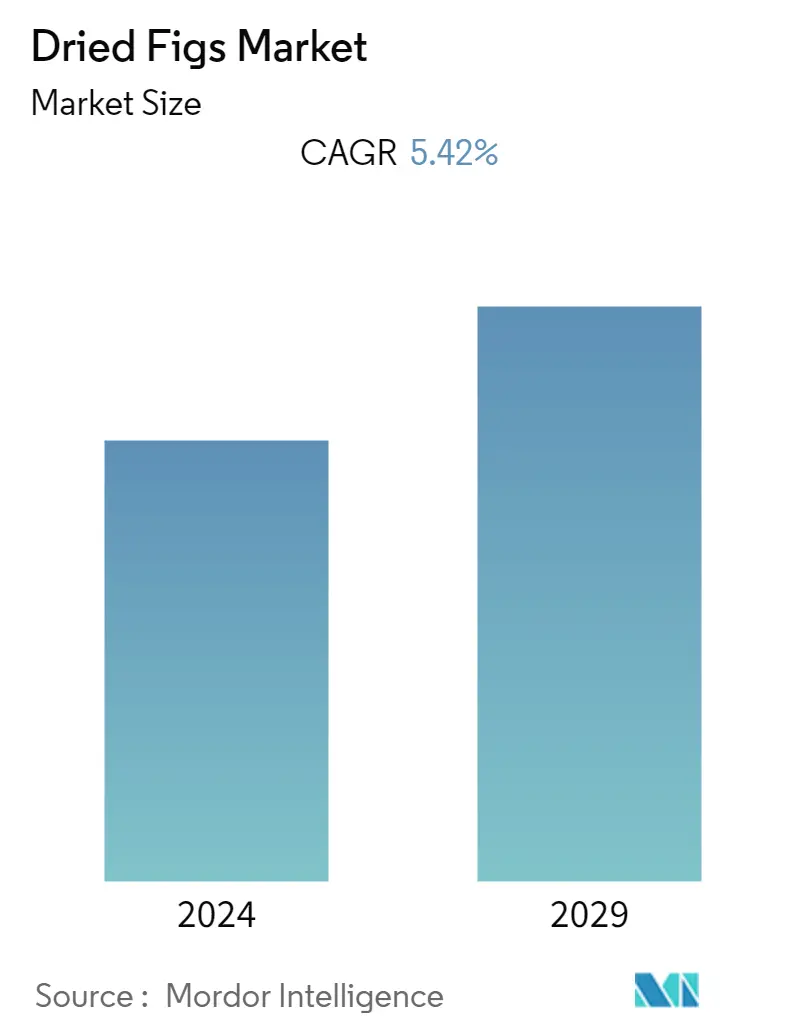Market Size of Dried Figs Industry

| Study Period | 2019 - 2029 |
| Base Year For Estimation | 2023 |
| Forecast Data Period | 2024 - 2029 |
| CAGR | 5.42 % |
| Fastest Growing Market | Middle East and North Africa |
| Largest Market | Middle East and North Africa |
Major Players*Disclaimer: Major Players sorted in no particular order |
Dried Figs Market Analysis
The Dried Figs Market size is expected to grow from USD 599.07 million in 2023 to USD 780 million by 2028, at a CAGR of 5.42% during the forecast period (2023-2028).
- Middle Eastern countries such as Turkey, Iran, and Afghanistan are among the top producers of dried figs. Turkey is the largest producer, accounting for about 70% of the world's dried fig production, followed by Iran, which accounts for around 15% of global production. The climate in these countries is well-suited for cultivating figs, and they have a long history of growing and exporting this fruit.
- Nearly 15-20% of the world's dry fig production is consumed by the producer countries, and the remaining portion of the domestic consumption of the producer countries is exported. Figs are produced in a limited number of countries worldwide due to their specific growing requirements. They thrive in warm, dry climates and require a specific type of wasp for pollination.
- Axcording to FAO, Turkey is the major producing country of figs, followed by Egypt, Iran, Morocco, Algeria, Iran, Syria, the USA, and Spain. In 2021, Turkey ranked first with approximately 300,000 tons of production and about 30% of World Wet fig production. The world's annual fig production was about 1,121,000 tons in 2021; dried fig production accounted for one-quarter of the fig production, with around 105.000 tons.
- According to the National Agricultural Statistics Service, the United States is both an importer and exporter of figs. While the country produces figs, over 80% of the figs produced in the United States go into processing industries due to the demand for dried figs. This is because dried figs have a longer shelf life and can be used in a variety of products, including baked goods, snacks, and breakfast cereals. As a result, the rising inclusion of figs in the processed industry will likely accelerate the demand for figs over the forecast period.
Dried Figs Industry Segmentation
Dried figs are the dehydrated form of the fig fruit of Ficus carica, a species of small tree in the flowering plant family Moraceae, native to the Mediterranean region, together with western and southern Asia. For the purpose of the study, only dry figs have been considered for analyzing the trends across various global demographics.
The dried figs market offers an analysis of production (volume), consumption (value and volume), import (value and volume), export (value and volume), and price trend. The market is segmented by geography (North America, Europe, Asia-Pacific, and the Middle East).
The market sizing has been done in value terms in USD for all the abovementioned segments.
| Geography (Production Analysis in Volume, Consumption Analysis by Volume and Value, Import Analysis by Value and Volume, Export Analysis by Value and Volume, and Price Trend Analysis) | |||||||||
| |||||||||
| |||||||||
| |||||||||
|
Dried Figs Market Size Summary
The dried figs market is poised for significant growth, driven by robust production in Middle Eastern countries, particularly Turkey, which dominates global production. The favorable climate and historical cultivation practices in these regions contribute to their leading position in the market. While a substantial portion of the dried figs produced is consumed domestically, a significant share is exported, highlighting the global demand for this fruit. The specific growing requirements of figs, including warm, dry climates and unique pollination needs, limit production to a few countries. The United States plays a dual role as both an importer and exporter, with a large portion of its production catering to the processing industry, where dried figs are valued for their extended shelf life and versatility in various food products.
The market's expansion is further supported by varying consumption patterns across different income economies, with high-income countries exhibiting a higher per capita consumption of dried figs. This trend presents opportunities for increased market penetration in these regions, despite limited domestic production. Countries like Germany rely heavily on imports to meet their demand, underscoring the global nature of the dried figs trade. Iran, a major producer and consumer, also plays a crucial role in the international market, with significant exports of dried figs. Recent developments, such as Turkey's introduction of functional fruit products and India's strategic trade initiatives, indicate ongoing efforts to enhance market reach and capitalize on the growing demand for dried figs worldwide.
Dried Figs Market Size - Table of Contents
-
1. MARKET DYNAMICS
-
1.1 Market Overview
-
1.2 Market Drivers
-
1.3 Market Restraints
-
1.4 Value Chain Analysis
-
-
2. MARKET SEGMENTATION
-
2.1 Geography (Production Analysis in Volume, Consumption Analysis by Volume and Value, Import Analysis by Value and Volume, Export Analysis by Value and Volume, and Price Trend Analysis)
-
2.1.1 North America
-
2.1.1.1 United States
-
2.1.1.2 Canada
-
2.1.1.3 Mexico
-
-
2.1.2 Europe
-
2.1.2.1 France
-
2.1.2.2 Germany
-
2.1.2.3 Russian Federation
-
2.1.2.4 United Kingdom
-
2.1.2.5 Italy
-
2.1.2.6 Switzerland
-
2.1.2.7 Greece
-
-
2.1.3 Asia-Pacific
-
2.1.3.1 India
-
2.1.3.2 China
-
2.1.3.3 Australia
-
-
2.1.4 Middle East
-
2.1.4.1 Iran
-
2.1.4.2 United Arab Emirates
-
2.1.4.3 Saudi Arabia
-
-
-
Dried Figs Market Size FAQs
What is the current Dried Figs Market size?
The Dried Figs Market is projected to register a CAGR of 5.42% during the forecast period (2024-2029)
Which is the fastest growing region in Dried Figs Market?
Middle East and North Africa is estimated to grow at the highest CAGR over the forecast period (2024-2029).

